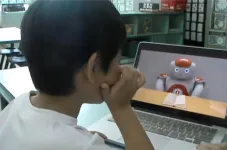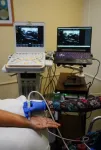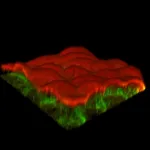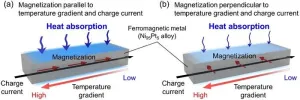(Press-News.org) Antibiotic-resistant bacteria have become a rapidly growing threat to public health. Each year, they account for more than 2.8 million infections, according to the U.S. Centers for Disease Control and Prevention. Without new antibiotics, even common injuries and infections harbor the potential to become lethal.
Scientists are now one step closer to eliminating that threat, thanks to a Texas A&M University-led collaboration that has developed a new family of polymers capable of killing bacteria without inducing antibiotic resistance by disrupting the membrane of these microorganisms.
“The new polymers we synthesized could help fight antibiotic resistance in the future by providing antibacterial molecules that operate through a mechanism against which bacteria do not seem to develop resistance,” said Dr. Quentin Michaudel, an assistant professor in the Department of Chemistry and lead investigator in the research, published Dec. 11 in the Proceedings of the National Academy of Sciences (PNAS).
Working at the interface of organic chemistry and polymer science, the Michaudel Laboratory was able to synthesize the new polymer by carefully designing a positively charged molecule that can be stitched many times to form a large molecule made of the same repeating charged motif using a carefully selected catalyst called AquaMet. According to Michaudel, that catalyst proves key, given that it has to tolerate a high concentration of charges and also be water-soluble — a feature he describes as uncommon for this type of process.
After achieving success, the Michaudel Lab put its polymers to the test against two main types of antibiotic-resistant bacteria — E. coli and Staphylococcus aureus (MRSA) — in collaboration with Dr. Jessica Schiffman’s group at the University of Massachusetts Amherst. While awaiting those results, the researchers also tested their polymers’ toxicity against human red blood cells.
“A common issue with antibacterial polymers is a lack of selectivity between bacteria and human cells when targeting the cellular membrane,” Michaudel explained. “The key is to strike a right balance between effectively inhibiting bacteria growth and killing several types of cells indiscriminately.”
Michaudel credits the multidisciplinary nature of scientific innovation and the generosity of dedicated researchers across the Texas A&M campus and country as factors in his team’s success in determining the perfect catalyst for their molecule assembly.
“This project was several years in the making and would not have been possible without the help of several groups, in addition to our UMass collaborators,” Michaudel said. “For instance, we had to ship some samples to the Letteri Lab at the University of Virginia to determine the length of our polymers, which required the use of an instrument that few labs in the country have. We are also tremendously grateful to [biochemistry Ph.D. candidate] Nathan Williams and Dr. Jean-Philippe Pellois here at Texas A&M, who provided their expertise in our assessment of toxicity against red blood cells.”
Michaudel says the team will now focus on improving the activity of its polymers against bacteria — specifically, their selectivity for bacterial cells versus human cells — before moving on to in vivo assays.
“We are in the process of synthesizing a variety of analogs with that exciting goal in mind,” he said.
The team’s paper, which features Michaudel Lab member and Texas A&M chemistry Ph.D. graduate Dr. Sarah Hancock ’23 as first author, can be viewed online along with related figures and captions. Other key contributors from the Michaudel Lab are chemistry graduate student An Tran ’23, postdoctoral scholar Dr. Arunava Maity and former postdoctoral scholar Dr. Nattawut Yuntawattana, who is now an assistant professor of materials science at Kasetsart University in Thailand.
This research was funded primarily by Michaudel’s National Institutes of Health Maximizing Investigators’ Research Award (MIRA) through the National Institute of General Medical Sciences.
A native of La Rochelle, France, Michaudel joined the Texas A&M Chemistry faculty in 2018 and holds a joint appointment in the Department of Materials Science and Engineering. In addition to an NIH MIRA in 2020, his career honors to date include a 2022 National Science Foundation Faculty Early Career Development (CAREER) Award, a 2022 American Chemical Society Polymeric Materials: Science and Engineering (PMSE) Young Investigator Award and a 2021 Thieme Chemistry Journals Award.
Learn more about Michaudel and his research at michaudellab.org.
END
Texas A&M team develops polymers that can kill bacteria
Dr. Quentin Michaudel and his research team have created a new family of polymers capable of killing bacteria without inducing antibiotic resistance — a major step in the fight against superbugs like E. coli and MRSA
2023-12-22
ELSE PRESS RELEASES FROM THIS DATE:
How jellyfish regenerate functional tentacles in days
2023-12-22
At about the size of a pinkie nail, the jellyfish species Cladonema can regenerate an amputated tentacle in two to three days — but how? Regenerating functional tissue across species, including salamanders and insects, relies on the ability to form a blastema, a clump of undifferentiated cells that can repair damage and grow into the missing appendage. Jellyfish, along with other cnidarians such as corals and sea anemones, exhibit high regeneration abilities, but how they form the critical blastema has remained a mystery until now.
A research team based in Japan has revealed that stem-like proliferative cells — which are actively growing and dividing but ...
Reindeer sleep while chewing their cud
2023-12-22
Researchers report December 22 in the journal Current Biology that the more time reindeer spend ruminating, the less time they spend in non-rapid eye movement (non-REM) sleep. EEG recordings revealed that reindeer’s brainwaves during rumination resemble the brain waves present during non-REM sleep, and these brainwave patterns suggest that the reindeer are more “rested” after ruminating. The researchers speculate that this multitasking might help reindeer get enough sleep during the summer months, when food is abundant ...
Trends in abdominoplasty: More outpatient surgery and concomitant liposuction
2023-12-22
Waltham — December 22, 2023 —
Abdominoplasty continues to be a safe and effective procedure, with more cases performed on an outpatient basis and increased use of concomitant liposuction, according to a new 16-year analysis in the January issue of Plastic and Reconstructive Surgery®, the official medical journal of the American Society of Plastic Surgeons (ASPS). The journal is published in the Lippincott portfolio by Wolters Kluwer.
"Taking advantage of quality-improvement data submitted by US Board-certified plastic surgeons, our study provides new insight ...
Like kids in a candy store
2023-12-22
Kyoto, Japan – A non-prescription drug abuse crisis in Japan seems only one overdose away. The demand for a particular anti-cough drug has been rising, along with the social impact of its abuse due to its psychosomatic effects.
The ease of obtaining information online about how to acquire over-the-counter medications or OTCs for achieving overdose, however, does not appear to be the real problem.
Now, a study by a team of researchers at Kyoto University suggests that reliable information about OTC abuse needs to be readily available and effectively disseminated.
"We ...
Robots versus humans: Which would children trust more when learning new information?
2023-12-22
In this digital age, children are exposed to overwhelming amounts of information online, some of it unverified and increasingly generated by non-human sources, such as AI-driven language models. As children grow older, the ability to assess a source’s reliability is an important skill in cultivating critical thinking.
Children aged three to five years display selective trust based on the informant’s past accuracy when faced with both humans and robots, according to a study published in the journal Child Development titled, ‘Younger, not older, ...
AI tool aids in screening for nerve disorder
2023-12-22
Researchers at the Indian Institute of Science (IISc), in collaboration with Aster-CMI Hospital, have developed an AI tool that can identify the median nerve in ultrasound videos and detect carpal tunnel syndrome (CTS). The study was published in IEEE Transactions on Ultrasonics, Ferroelectrics, and Frequency Control.
CTS arises when the median nerve, which runs from the forearm into the hand, is compressed at the carpal tunnel part of the wrist, resulting in numbness, tingling or pain. It ...
Big impacts from small changes in cell
2023-12-22
Tiny things matter – for instance, one amino acid can completely alter the architecture of the cell. Researchers at the Universities of Göttingen and Warwick investigated the structure and mechanics of the main component of the cytoskeleton of the cell: a protein known as actin. Actin is found in all living cells where it has a range of important functions – from muscle contraction to cell signalling and cell shape. This protein comes in two different varieties termed “isoforms”, which are known as gamma actin and beta actin. The difference between the two proteins is ...
Jupiter was targeted by exoplanet hunter
2023-12-22
For the first time, an instrument to find planets light years away was used on an object in the Solar System, in a study on Jupiter's winds.
We find ourselves at a time when it has become almost commonplace to discover planets orbiting another star, with more than 5,000 already registered. The first distant worlds to incorporate this list were mainly giant planets, similar to but also very different in many ways from Jupiter and Saturn.
Astrophysicists have already begun to obtain data on the atmospheres of exoplanets, but fundamental ...
Pandemic lessons: Insights into how mobility restrictions affect healthcare costs
2023-12-22
Osaka, Japan - As the world grappled with lockdowns and restrictions brought by the COVID-19 pandemic, researchers at Osaka Metropolitan University conducted an extensive study to elucidate the link between changes in human mobility and the impact on medical costs associated with lifestyle-related diseases.
Dr. Haruka Kato and Professor Atsushi Takizawa of the Graduate School of Human Life and Ecology at Osaka Metropolitan University were concerned by the negative health effects resulting from the restriction of ...
Controlling thermoelectric conversion in magnetic materials by magnetization direction
2023-12-22
1. NIMS has succeeded in directly observing the "anisotropic magneto-Thomson effect," a phenomenon in which the heat absorption/release proportional to an applied temperature difference and charge current (i.e., Thomson effect) changes anisotropically depending on the magnetization direction in magnetic materials. This research is expected to lead to further development of basic physics and materials science related to the fusion area of thermoelectrics and spintronics, as well as to development of new functionalities to control thermal energy with magnetism.
2. The Thomson effect has long been known as one of the fundamental ...
LAST 30 PRESS RELEASES:
The vast majority of US rivers lack any protections from human activities, new research finds
Ultrasound-responsive in situ antigen "nanocatchers" open a new paradigm for personalized tumor immunotherapy
Environmental “superbugs” in our rivers and soils: new one health review warns of growing antimicrobial resistance crisis
Triple threat in greenhouse farming: how heavy metals, microplastics, and antibiotic resistance genes unite to challenge sustainable food production
Earthworms turn manure into a powerful tool against antibiotic resistance
AI turns water into an early warning network for hidden biological pollutants
Hidden hotspots on “green” plastics: biodegradable and conventional plastics shape very different antibiotic resistance risks in river microbiomes
Engineered biochar enzyme system clears toxic phenolic acids and restores pepper seed germination in continuous cropping soils
Retail therapy fail? Online shopping linked to stress, says study
How well-meaning allies can increase stress for marginalized people
Commercially viable biomanufacturing: designer yeast turns sugar into lucrative chemical 3-HP
Control valve discovered in gut’s plumbing system
George Mason University leads phase 2 clinical trial for pill to help maintain weight loss after GLP-1s
Hop to it: research from Shedd Aquarium tracks conch movement to set new conservation guidance
Weight loss drugs and bariatric surgery improve the body’s fat ‘balance:’ study
The Age of Fishes began with mass death
TB harnesses part of immune defense system to cause infection
Important new source of oxidation in the atmosphere found
A tug-of-war explains a decades-old question about how bacteria swim
Strengthened immune defense against cancer
Engineering the development of the pancreas
The Journal of Nuclear Medicine ahead-of-print tip sheet: Jan. 9, 2026
Mount Sinai researchers help create largest immune cell atlas of bone marrow in multiple myeloma patients
Why it is so hard to get started on an unpleasant task: Scientists identify a “motivation brake”
Body composition changes after bariatric surgery or treatment with GLP-1 receptor agonists
Targeted regulation of abortion providers laws and pregnancies conceived through fertility treatment
Press registration is now open for the 2026 ACMG Annual Clinical Genetics Meeting
Understanding sex-based differences and the role of bone morphogenetic protein signaling in Alzheimer’s disease
Breakthrough in thin-film electrolytes pushes solid oxide fuel cells forward
Clues from the past reveal the West Antarctic Ice Sheet’s vulnerability to warming
[Press-News.org] Texas A&M team develops polymers that can kill bacteriaDr. Quentin Michaudel and his research team have created a new family of polymers capable of killing bacteria without inducing antibiotic resistance — a major step in the fight against superbugs like E. coli and MRSA








